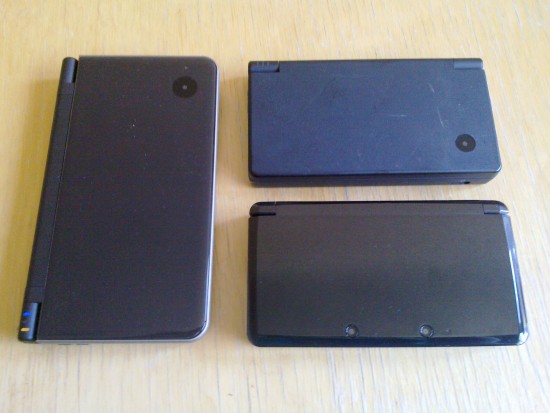App Store and Downloads
Since the machine has only been released in late March, much of its functionality hasn’t made an appearance yet. At the time of writing the new Nintendo eStore hasn’t launched yet, neither has the Internet browser or the app that lets your transfer previously purchased games from your DSi consoles. This has been announced and I’m sure it’s coming – when however is a mystery.
Once eStore launches I would imagine that’s where we find downloadable movie and video content. Watch this space!
Screens and Resolutions
Like on previous models, the bottom dispay is a touch screen (in 2D) and the top one is the magic 3D widescreen display. Both screens can display 24-bit colours.
The 16:9 3D screen has a resolution of 800×240 pixels (that’s 400×240 per eye) whereas the bottom one is a 4:3 screen that displays at 320×240 pixels. Screen diagonals measure 3.5″ for the top and 3″ for the bottom display.
If you’re running native DS and DSi titles on this puppy you’ll discover an inevitable amount of up-rezzing involved: the DS and DSi consoles were running both displays at 256×192 pixels. Not only will the top screen revert back to 4:3 (adding black sidebars), you’ll also notice that the picture will look as small as it did on the DS Lite… overall not a great user experience for non-3DS titles I must admit. But hey, they work – maybe we should be happy about that.
For the 3D effect to work properly you’re best advised not to move the console. That’s a rather difficult task if you’re playing a game where you’re moving around – inevitably you’ll tilt the console. It’s just what happens. However this also yanks you out of the perfect 3D vision angle and thereby ruining your experience somewhat. You can of course turn the 3D effect off (which I find myself doing every once in a while) but the question then arises as to what the point in playing a 3D game is.
I can see the top screen working well for 3D video footage for a single viewer. Nintendo have included a 2min 3D video compilation entitled “For a Limited Time” which features nature, sports and time-lapse footage. Looking gooooood!
I found that the display looks great indoors, featuring vibrant clear colours and contrasts. Like many backlit shiny displays the 3DS suffers from poor visibility outdoors. That’s a bit disappointing for taking 3D pictures since your only viewfinder is the upper screen. Even in overcast conditions it’s almost impossible to make out what’s on the screen.
What about the Camera?
We’re dealing with 3 cameras in total on the 3DS: one facing you and two facing the outside world. You guessed it: these can capture 3D images.
Currently you can only shoot stills like on older DS models, however the frame rate looks OK when used in games so I wonder if Nintendo will roll out 3D video recording with this device a bit later.
3D caputres are saved as two independant files onto the SD card: one .JPG image and one .MPO file of the same size (which is the other picture with a different ending). All images are saved in the DCIM folder onto the SD card. This approach is quite clever because it guarantees backward compatibility with standard image kiosks and photo software – there’s no need for un-3D-ing your pictures, you can use them as they are.
Resolution hasn’t changed from the predecessors here: we’re dealing with 0.3MP cameras that can capture at 640×480.
Battery Life
Let me be brutally honest here: it sucks. Period. That’s why they give you a charging cradle.
Granted the little guy does a lot of hard work but on a full charge you’ll have about 3 hours of gaming, maybe 5 if you don’t use AR games (which rely on using the cameras). It’s on par with my 6 year old PSP-1000.
That’s a rather different ball game compared to previous consoles: the DSi XL sports 14 hours of gaming on one charge, whereas the little DSi lasts for about 9 hours.

Games and Applications
I felt that the system performed a bit sluggish compared to the DSi: you actually have to wait 10-15 seconds until your applications have loaded. That may not seem a lot, but when you’re used to things being ready at a click it feels slow. But maybe that’s just me.
Once an app or a game has loaded you can put it on hold by pressing the Home button – this lets you temporarily pause an app to access the dashboard interface. Make a note, check the time, adjust the screen brightness etc.